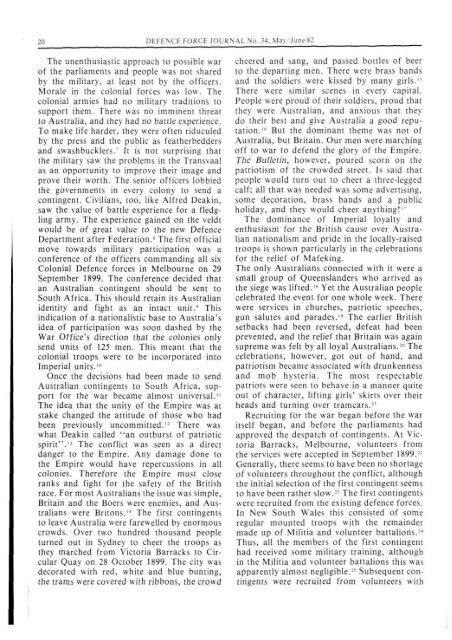ISSUE 34 : May/Jun - 1982 - Australian Defence Force Journal
ISSUE 34 : May/Jun - 1982 - Australian Defence Force Journal
ISSUE 34 : May/Jun - 1982 - Australian Defence Force Journal
You also want an ePaper? Increase the reach of your titles
YUMPU automatically turns print PDFs into web optimized ePapers that Google loves.
20 DEFENCE FORCE JOURNAL No. <strong>34</strong>, <strong>May</strong> <strong>Jun</strong>e 82<br />
The unenthusiastic approach to possible war<br />
of the parliaments and people was not shared<br />
by the military, at least not by the officers.<br />
Morale in the colonial forces was low. The<br />
colonial armies had no military traditions to<br />
support them. There was no imminent threat<br />
to Australia, and they had no battle experience.<br />
To make life harder, they were often riduculed<br />
by the press and the public as featherbedders<br />
and swashbucklers." It is not surprising that<br />
the military saw the problems in the Transvaal<br />
as an opportunity to improve their image and<br />
prove their worth. The senior officers lobbied<br />
the governments in every colony to send a<br />
contingent. Civilians, too, like Alfred Deakin,<br />
saw the value of battle experience for a fledgling<br />
army. The experience gained on the veldt<br />
would be of great value to the new <strong>Defence</strong><br />
Department after Federation." The first official<br />
move towards military participation was a<br />
conference of the officers commanding all six<br />
Colonial <strong>Defence</strong> forces in Melbourne on 29<br />
September 1899. The conference decided that<br />
an <strong>Australian</strong> contingent should be sent to<br />
South Africa. This should retain its <strong>Australian</strong><br />
identity and fight as an intact unit.'' This<br />
indication of a nationalistic base to Australia's<br />
idea of participation was soon dashed by the<br />
War Office's direction that the colonies only<br />
send units of 125 men. This meant that the<br />
colonial troops were to be incorporated into<br />
Imperial units. 1 "<br />
Once the decisions had been made to send<br />
<strong>Australian</strong> contingents to South Africa, support<br />
for the war became almost universal."<br />
The idea that the unity of the Empire was at<br />
stake changed the attitude of those who had<br />
been previously uncommitted. 12 There was<br />
what Deakin called "an outburst of patriotic<br />
spirit".' 3 The conflict was seen as a direct<br />
danger to the Empire. Any damage done to<br />
the Empire would have repercussions in all<br />
colonies. Therefore the Empire must close<br />
ranks and fight for the safety of the British<br />
race. For most <strong>Australian</strong>s the issue was simple,<br />
Britain and the Boers were enemies, and <strong>Australian</strong>s<br />
were Britons. 14 The first contingents<br />
to leave Australia were farewelled by enormous<br />
crowds. Over two hundred thousand people<br />
turned out in Sydney to cheer the troops as<br />
they marched from Victoria Barracks to Circular<br />
Quay on 28 October 1899. The city was<br />
decorated with red, white and blue bunting,<br />
the trams were covered with ribbons, the crowd<br />
cheered and sang, and passed bottles of beer<br />
to the departing men. There were brass bands<br />
and the soldiers were kissed by many girls.''<br />
There were similar scenes in every capital.<br />
People were proud of their soldiers, proud that<br />
they were <strong>Australian</strong>, and anxious that they<br />
do their best and give Australia a good reputation.<br />
1 " But the dominant theme was not of<br />
Australia, but Britain. Our men were marching<br />
off to war to defend the glory of the Empire.<br />
The Bulletin, however, poured scorn on the<br />
patriotism of the crowded street. Is said that<br />
people would turn out to cheer a three-legged<br />
calf; all that was needed was some advertising,<br />
some decoration, brass bands and a public<br />
holiday, and they would cheer anything! 1 "<br />
The dominance of Imperial loyalty and<br />
enthusiasm for the British cause over <strong>Australian</strong><br />
nationalism and pride in the locally-raised<br />
troops is shown particularly in the celebrations<br />
for the relief of Mafeking.<br />
The only <strong>Australian</strong>s connected with it were a<br />
small group of Queenslanders who arrived as<br />
the siege was lifted.'* Yet the <strong>Australian</strong> people<br />
celebrated the event for one whole week. There<br />
were services in churches, patriotic speeches,<br />
gun salutes and parades. 19 The earlier British<br />
setbacks had been reversed, defeat had been<br />
prevented, and the relief that Britain was again<br />
supreme was felt by all loyal <strong>Australian</strong>s. 2 " The<br />
celebrations, however, got out of hand, and<br />
patriotism became associated with drunkenness<br />
and mob hysteria. The most respectable<br />
patriots were seen to behave in a manner quite<br />
out of character, lifting girls' skirts over their<br />
heads and turning over tramcars. 21<br />
Recruiting for the war began before the war<br />
itself began, and before the parliaments had<br />
approved the despatch of contingents. At Victoria<br />
Barracks, Melbourne, volunteers from<br />
the services were accepted in September 1899."<br />
Generally, there seems to have been no shortage<br />
of volunteers throughout the conflict, although<br />
the initial selection of the first contingent seems<br />
to have been rather slow. 2 ' The first contingents<br />
were recruited from the existing defence forces.<br />
In New South Wales this consisted of some<br />
regular mounted troops with the remainder<br />
made up of Militia and volunteer battalions. 24<br />
Thus, all the members of the first contingent<br />
had received some military training, although<br />
in the Militia and volunteer battalions this was<br />
apparently almost negligible. 2 ' Subsequent contingents<br />
were recruited from volunteers with

















